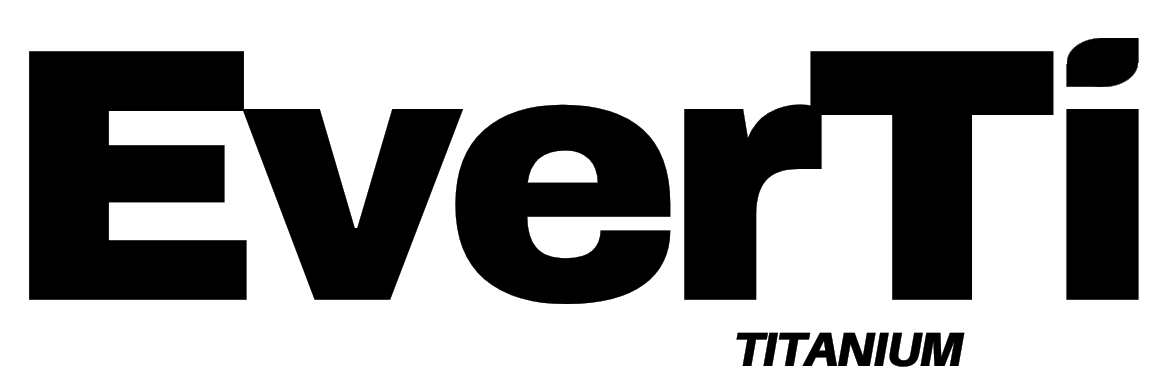The path to a healthier meal doesn't just start with buying fresh, organic ingredients—it begins with the very surface you cook on. The best healthy cooking pans are crafted from non-reactive, non-toxic materials like pure titanium, cast iron, and 316-grade stainless steel, which won’t leach nasty chemicals into your food. Picking the right pan is a crucial, yet often forgotten, part of building a truly healthy kitchen.
Why Your Cookware Is a Key Ingredient
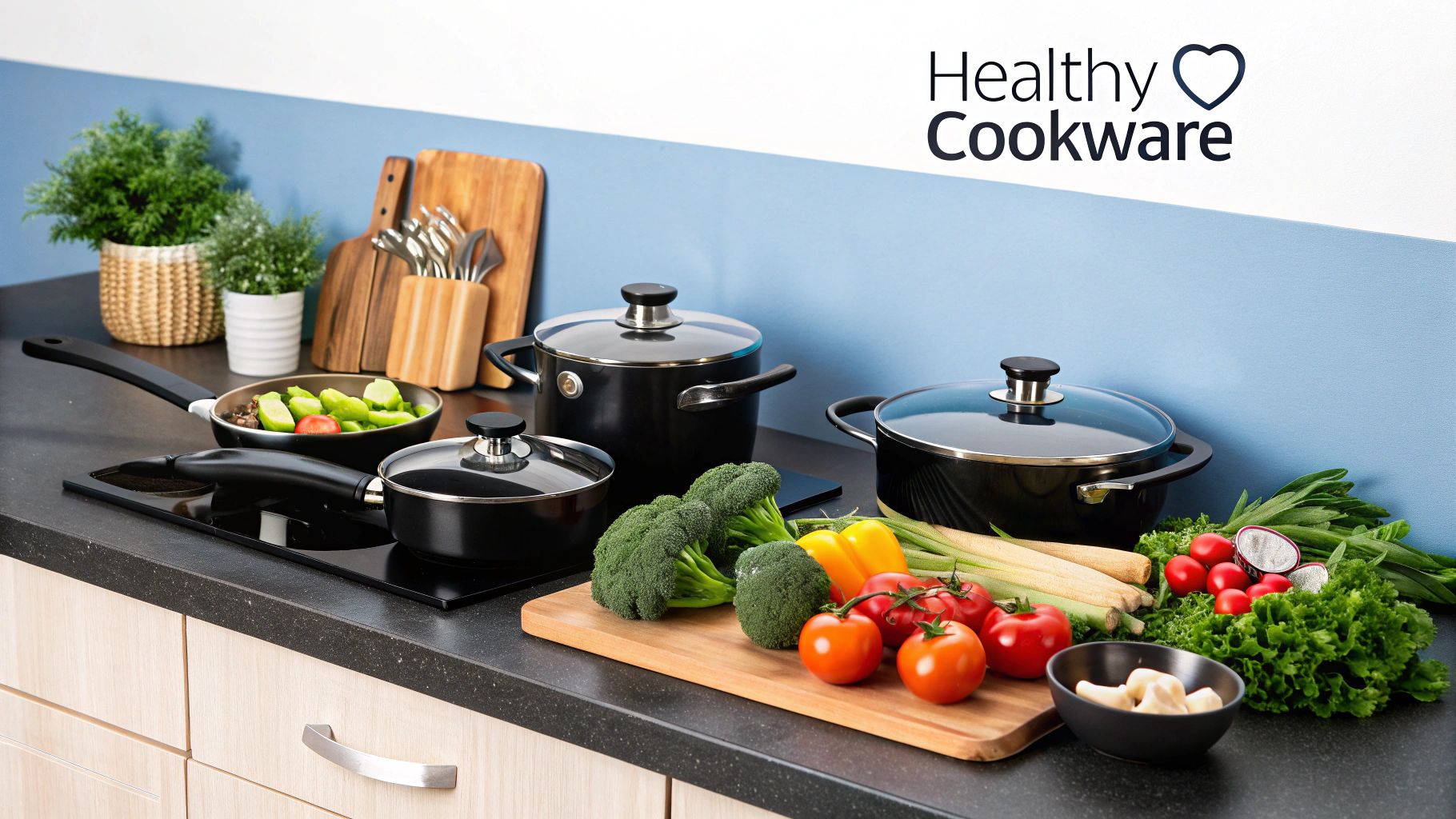
It’s easy to spend a lot of time and effort choosing the best ingredients, from farm-fresh vegetables to high-quality proteins. But the cookware you use is the silent partner in every single dish you make. It’s in direct contact with your food under intense heat, which means its composition can either support your health goals or work against them.
Think of your pan's surface as a gatekeeper for your food. Certain materials, especially older non-stick coatings, can start to break down at high temperatures, releasing unwanted chemicals straight into your meal. On the flip side, stable and inert materials act as a protective barrier, keeping the integrity, flavour, and nutritional value of your food right where it belongs. A truly healthy cooking pan really comes down to a mix of three essential qualities:
- Material Safety: It has to be free from harmful stuff like PFOA, PFAS, lead, and cadmium that can seep into your food.
- Cooking Performance: It needs to distribute heat evenly, cooking food properly without creating frustrating hot spots that burn one side and undercook the other.
- Long-Term Durability: A quality pan should be able to stand up to scratches and daily wear, ensuring it stays a safe cooking surface for years to come.
The Growing Demand for Safer Kitchens
This move towards more mindful cooking isn't just a fleeting trend; it shows a much deeper understanding of what it means to be well. Australian consumers, in particular, are putting health front and centre in their kitchens. This focus has spurred on some serious growth in the local cookware market, which was valued at USD 664.44 million in 2024 and is expected to more than double by 2033.
That kind of growth sends a clear message: there's a huge demand for reliable, healthy cooking pans that families can genuinely trust. You can explore more about the Australian cookware market trends and see how what people want is changing the industry.
A healthy kitchen isn't just about the food you buy; it's about the tools you trust. Your choice in cookware is a daily decision that contributes to your family’s long-term well-being.
When you're standing in the cookware aisle, the sheer number of options can feel overwhelming. It's not just about a pan that cooks your food; it's about choosing the right tool for the job—one that's safe, durable, and performs the way you need it to.
Think of it like this: some pans are fantastic sprinters, great for a quick, specific task, while others are marathon runners, built for the long haul. Let's walk through the most common materials you'll find, so you can understand their real-world strengths and weaknesses.
https://www.youtube.com/embed/lCgD9FweFvk
The Story of Traditional Non-Stick (PTFE)
For decades, if you wanted a pan that food wouldn't stick to, you were likely buying something coated with polytetrafluoroethylene (PTFE). You probably know it by its most famous brand name: Teflon. These pans made life easy. Flipping pancakes was a joy, and omelettes slid right out. It’s no wonder they became a kitchen staple.
But over time, questions started popping up about the chemicals used to make them, especially a compound called perfluorooctanoic acid (PFOA). The concern was that if these pans got too hot or the surface was scratched, the coating could break down and release fumes or tiny particles. While PFOA has now been largely phased out of production, the allure of a slick, easy-to-clean pan keeps this market buzzing.
And it's a big market. The non-stick cookware scene in Australia and New Zealand was valued at a whopping USD 254.62 million in 2024 and is expected to grow to USD 356.78 million by 2032. If you're curious about the numbers, you can read the full research on non-stick cookware trends.
This handy visual below breaks down the health trade-offs for some of the most popular cookware choices.
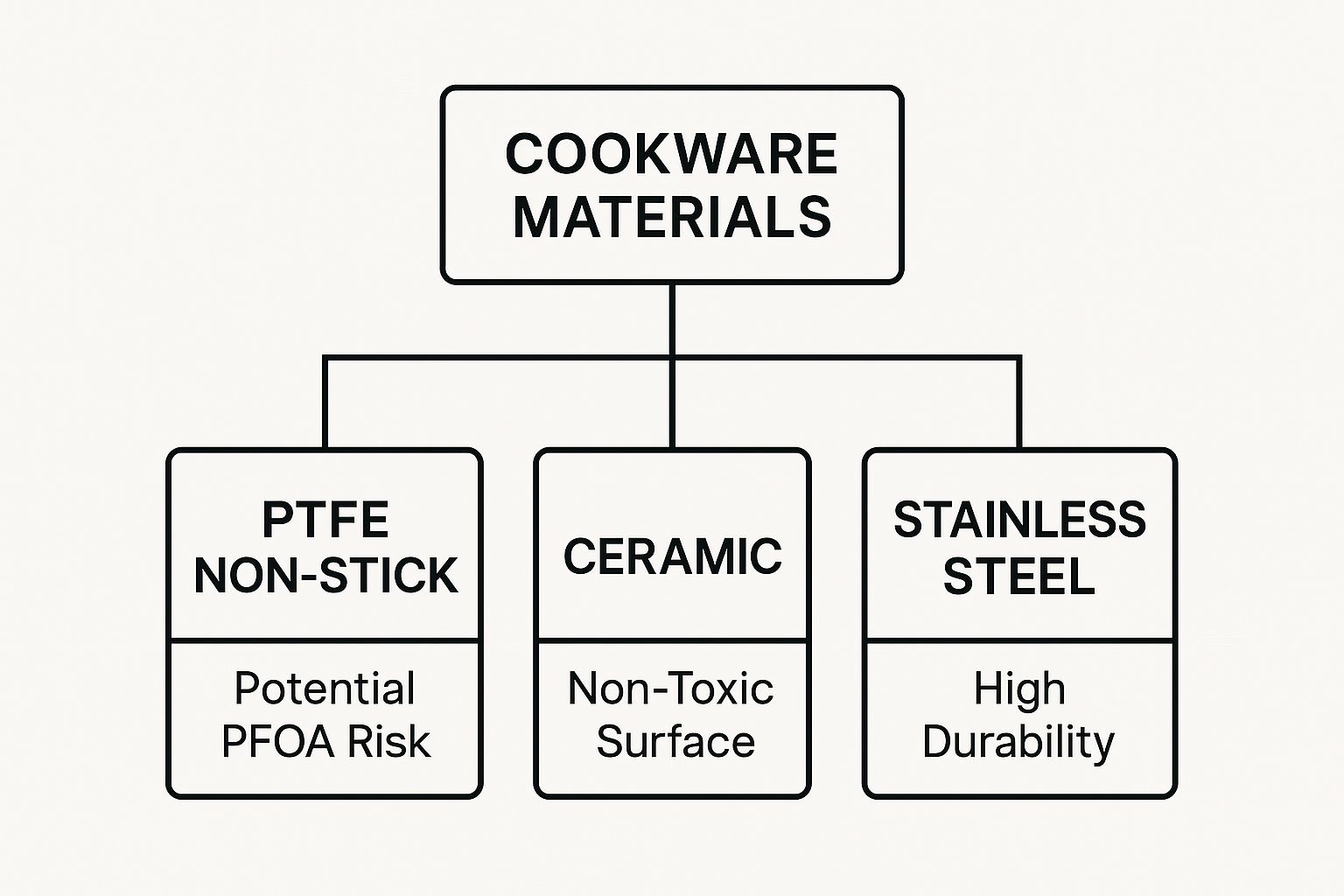
As you can see, it paints a clear picture: materials like ceramic are positioned as non-toxic from the get-go, while the potential risks of older PTFE coatings are noted, and the sheer durability of stainless steel stands out.
Cookware Material Health and Safety Snapshot
To make things even clearer, here’s a quick comparison table to help you weigh the pros and cons of each material at a glance. It's designed to cut through the marketing jargon and give you the essential facts.
| Material Type | Potential Health Concerns | Key Safety Benefits | Best For |
|---|---|---|---|
| Traditional Non-Stick (PTFE) | Fumes from overheating; potential for PFOA in older pans. | Excellent food release with minimal oil; modern versions are PFOA-free. | Everyday cooking for delicate foods like eggs and fish, especially for beginners. |
| Ceramic | None, but coating can chip or wear, potentially exposing the metal underneath. | PFOA and PTFE-free; a naturally non-toxic surface. | Low-to-medium heat cooking of non-abrasive foods; great for those prioritising a toxin-free kitchen. |
| Cast Iron | Can leach small amounts of iron (often a benefit); reactive with acidic foods. | Extremely durable; develops a natural, non-stick "seasoning." | Searing, frying, and baking. Anything that needs high heat and can go from stovetop to oven. |
| Stainless Steel | Leaching of nickel or chromium is possible but generally very low. | Highly durable, stable, and non-reactive with most foods. | All-purpose cooking, especially for sauces, searing, and sautéing where you want fond to develop. |
| Titanium | None. It's one of the most inert and biocompatible materials available. | Completely non-toxic, non-reactive, and incredibly durable. | The health-conscious cook who wants a versatile, lifelong pan for any and all types of cooking. |
This snapshot shows there’s no single "perfect" pan for everyone, but there's definitely a best choice for your health priorities and cooking style.
Ceramic Cookware: The Non-Toxic Alternative
When people started looking for an alternative to traditional non-stick, ceramic-coated pans stepped into the spotlight. The coating is basically a sand-based, mineral layer baked onto a metal core (usually aluminium). It's naturally slick and completely free from PTFE and PFOA.
Ceramic pans are brilliant for cooking delicate things like fish or eggs with very little oil. The biggest catch? Durability. That ceramic coating, as great as it is, tends to wear down. After a year or two of regular use, you might find it's lost its non-stick magic, especially if you’ve used metal utensils or abrasive sponges.
The thing to remember with ceramic is that you get fantastic non-toxic performance right out of the box, but its lifespan is often much shorter than other materials. You'll likely need to replace it more often to keep it working well.
Cast Iron: The Timeless Workhorse
There’s a reason cast iron pans are passed down through generations. They're practically indestructible. These heavy-duty pans are famous for their incredible heat retention—once they get hot, they stay hot.
After you "season" it (which just means baking on a thin layer of oil), a cast iron pan develops a natural, slick surface that actually gets better the more you cook with it. It's the go-to for getting a perfect sear on a steak or frying crispy chicken. The trade-offs are its weight and the care it needs. You have to clean it gently and keep it seasoned to prevent rust.
- Pros: Holds heat like nothing else, gets naturally non-stick over time, and will literally last a lifetime.
- Cons: It's heavy, needs a bit of special maintenance, and can react with acidic foods like tomato sauce.
Stainless Steel: The Professional's Choice
Peek inside nearly any professional kitchen, and you’ll see stainless steel pans everywhere. Chefs love them because they are tough, non-reactive, and give you fantastic cooking results, especially when they have a core of aluminium or copper to help spread the heat evenly.
There's no non-stick coating here, so there is a bit of a learning curve. The secret is to preheat the pan properly and use the right amount of oil. But because it's non-reactive, you can cook anything in it—from acidic tomato sauces to delicate scallops—without worrying about it leaching chemicals or a metallic taste into your food. When building a quality kitchen, many people find that pairing a few great stainless steel pans with versatile non-stick frying pans with lids gives them the best of both worlds.
Titanium: A Modern Fusion of Strengths
This is where modern material science really shines. Titanium cookware takes the best qualities of other materials and rolls them into one superior package. Pure titanium is completely inert and biocompatible, which is just a fancy way of saying it’s non-toxic and won't react with your food, period.
It’s also incredibly strong but surprisingly light, making it far easier to handle day-to-day than a heavy cast iron pan. On top of that, it’s exceptionally durable and scratch-resistant, so you can count on it lasting a lifetime without degrading. When it's bonded to other metals for even heat distribution, titanium truly becomes the ultimate choice for anyone serious about health, performance, and long-term value in the kitchen.
The Enduring Appeal of Stainless Steel Cookware
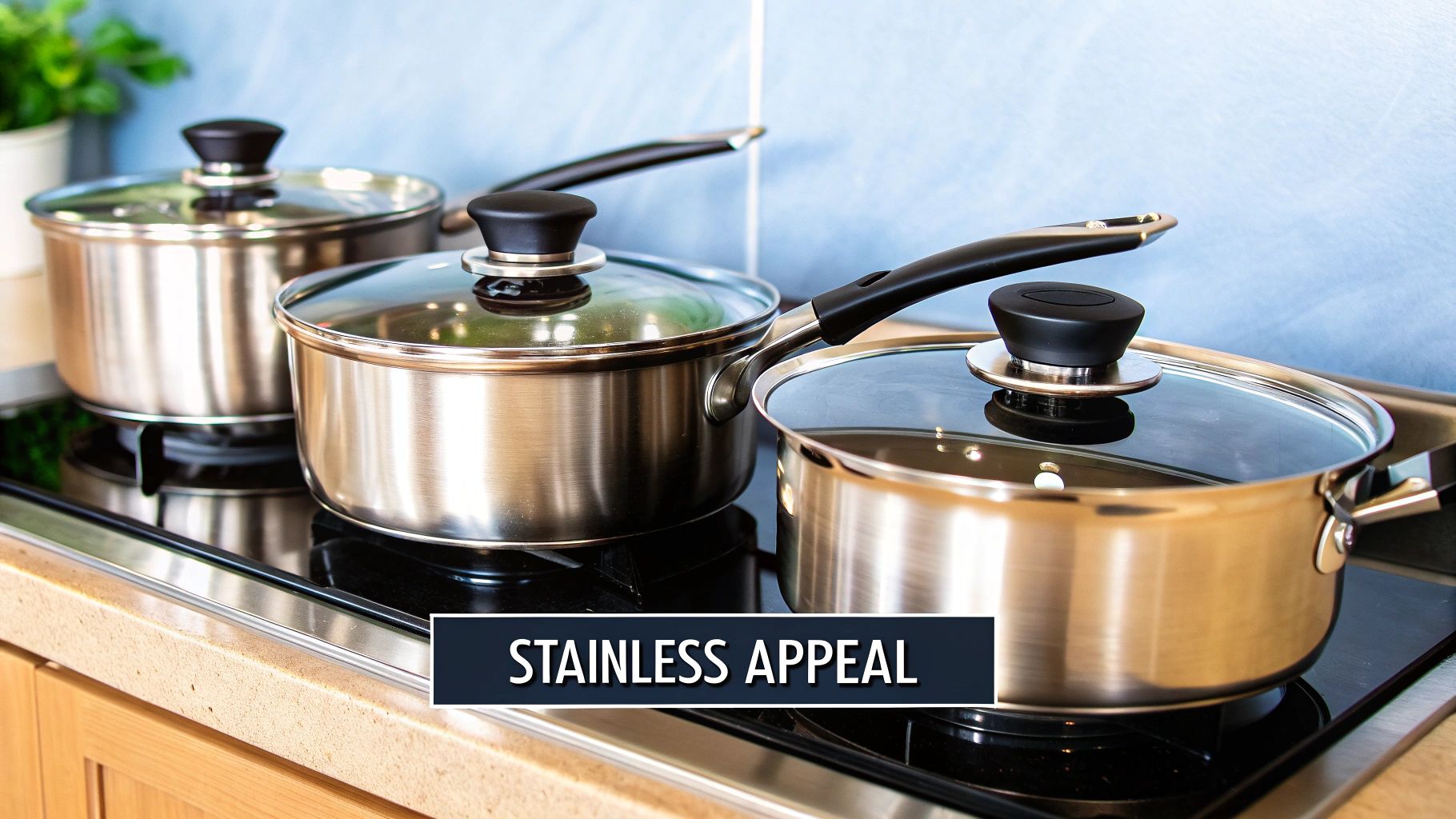
If you peek into almost any professional kitchen, you'll see stainless steel pans everywhere. There's a good reason for that. This material is a true workhorse, loved by chefs and home cooks alike for its incredible durability, versatility, and—most importantly—its stability. When you're on the hunt for healthy cooking pans, stainless steel is one of the most reliable and time-tested options out there.
Its biggest health advantage is that it’s non-reactive. Think of it as a completely neutral container that won't mess with what you put inside. You can simmer a rich, acidic tomato sauce for hours or deglaze a pan with wine and never have to worry about metal leaching into your food or leaving a weird metallic taste. This stability means the pure flavour of your ingredients gets to be the star.
It's no surprise that more and more people are turning to these trusty pans. In 2024, pots and pans were the biggest players in the Australian stainless steel cookware market, making up around 44.48% of the total revenue. And that's not slowing down. The market is expected to keep growing as Aussies continue to choose healthy, long-lasting cookware. You can discover more about the trends in stainless steel cookware to see the full picture.
Understanding Stainless Steel Grades
When you're shopping for stainless steel, you'll notice numbers like 18/8 or 18/10 stamped on the bottom. These aren't just random codes—they're a cheat sheet to the pan's quality.
- The first number (18): This tells you the percentage of chromium in the steel alloy. Chromium is the key ingredient that makes the pan resistant to rust and corrosion.
- The second number (8 or 10): This is the percentage of nickel. Nickel boosts the steel's shine and adds another layer of defence against corrosion, especially from acidic foods.
Generally speaking, an 18/10 pan is considered the premium choice. It offers better durability and a brighter, more polished finish, making it exceptionally good at resisting stains and pitting over its long lifetime.
Mastering the Art of Cooking on Steel
The biggest learning curve for anyone new to stainless steel is the lack of a synthetic non-stick coating. It’s a common complaint that food sticks, but this is almost always down to technique, not the pan itself. The secret? Proper heat management.
Before you even think about adding oil or food, you need to preheat your pan correctly. The "water test" is your best friend here. Just heat the dry pan over a medium flame and flick a few drops of water onto the surface. If they form into little beads that dance and glide around like mercury, your pan is at the perfect temperature.
This fascinating little trick is called the Leidenfrost effect. It creates a tiny cushion of vapour between the hot pan and your food, which acts as a natural non-stick barrier. Once you get the hang of this simple step, you'll realise how easy it is to cook with stainless steel, from getting the perfect sear on a steak to sautéing delicate vegetables. It's a skill that will seriously level up your cooking and make that healthy pan a worthwhile investment for years to come.
Why Titanium Is the Gold Standard for Healthy Pans
So, we've looked at solid choices like stainless steel, and it's obvious that durability and non-reactivity are the foundations of a healthy kitchen. But what if you could have all that, plus incredible non-stick performance and a pan that's light enough to flip with ease, all without any questionable chemicals? That's precisely where titanium cookware comes in, raising the bar for what healthy cooking pans should be.
Think about this for a moment: titanium is the same material trusted by surgeons for medical implants placed inside the human body. That's not just a cool fact; it's a powerful statement about its safety. When that level of biocompatibility is brought into the kitchen, it means the material is completely inert.
This inertness is titanium’s secret weapon. It won’t react with acidic ingredients like tomato sauce or a squeeze of lemon, which means the pure, true flavour of your food is all you'll ever taste. There’s absolutely zero risk of metals or other nasties leaching into your meals, no matter what you're cooking.
The Science of Unmatched Purity
The trust placed in titanium comes down to its unique atomic makeup. The moment it's exposed to air, it forms an incredibly thin but tough layer of titanium dioxide on its surface. This passive oxide layer is the key to its non-reactive, super-safe nature.
You can think of this layer as a natural, built-in shield. It’s self-healing and protects the metal underneath from rust, corrosion, and chemical reactions. This is a world away from synthetic non-stick coatings that can get scratched or break down over time. With titanium, the safety is part of the material itself.
This incredible stability is why you see titanium used in really demanding fields, from aerospace engineering to surgical tools and joint replacements. If it's safe enough to be permanently inside the body, you can feel completely confident using it for your family's food.
A Fusion of the Best Qualities
Titanium cookware brilliantly solves the compromises you often have to make with other materials. It manages to blend the best features into one high-performance package.
- Non-Reactivity of Stainless Steel: Just like high-quality stainless steel, titanium won't mess with the taste of your food or leach anything unwanted.
- Lightweight and Easy to Handle: It's incredibly light for its strength, unlike heavy cast iron, making it a dream for everyday use.
- Superior Durability: Titanium is exceptionally tough, resisting scratches, warping, and dings. With the right care, it's a pan for life.
- Effortless Non-Stick Performance: When made well, titanium surfaces offer fantastic food release without needing PFOA, PFAS, or other chemical coatings that degrade.
This blend of features makes titanium pans a smart long-term investment. You get the peace of mind from knowing your cookware is fundamentally safe, combined with the practical performance that makes cooking fun again. For anyone wanting to dig deeper, our guide on titanium cookware in Australia explores what truly sets this material apart.
Titanium isn't just another option; it's the culmination of what health-conscious cooks have been looking for—a pan that delivers uncompromising safety, professional-grade performance, and lifelong durability.
Heat Distribution and Cooking Efficiency
On its own, pure titanium isn't a great heat conductor. To get around this, premium titanium pans are built using a multi-ply design, bonding the titanium cooking surface to a super-conductive core, usually aluminium or copper.
This layered construction is the secret to its flawless performance. The aluminium or copper core heats up fast and spreads that heat evenly across the bottom and up the sides of the pan. This gets rid of those annoying hot spots that burn your food in one area while leaving another part undercooked.
The result is beautifully precise temperature control. You can get that perfect, edge-to-edge sear on a steak, gently simmer a delicate sauce without it catching, or sauté vegetables to a perfect, consistent crispness. This efficiency doesn't just make your food better—it can also save energy, as you can often cook at lower temperatures once the pan is hot. It’s this kind of thoughtful engineering that turns a simple pan into an essential kitchen tool.
How to Care for Your Healthy Cookware
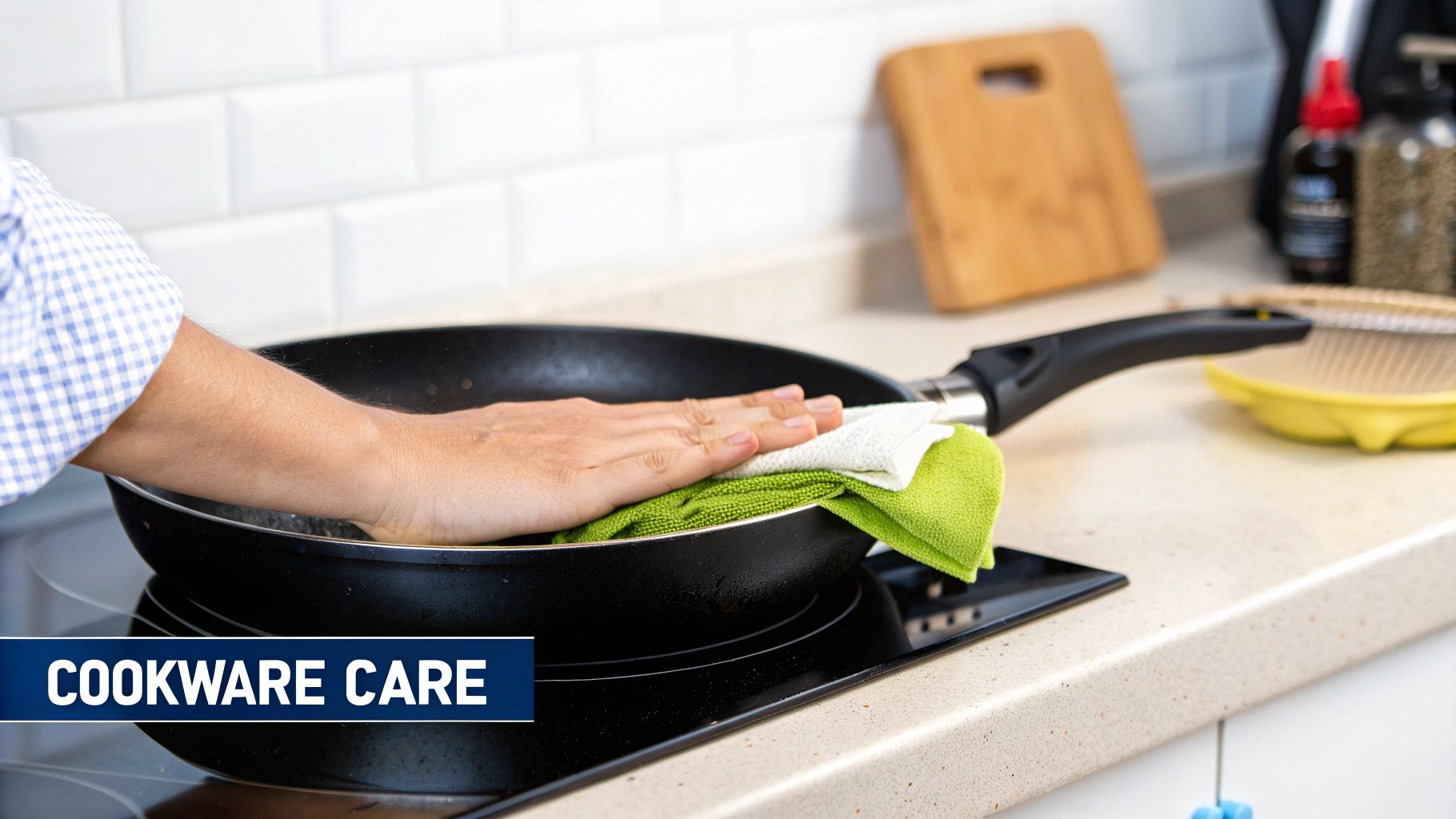
So, you've invested in some top-notch, healthy cooking pans. That's a brilliant first move for a safer kitchen. But the journey doesn't end there. Knowing how to properly care for them is just as important. It’s not just about aesthetics; it's about making sure the cooking surface stays intact, non-toxic, and performs flawlessly for years to come.
Every material is a little different. A gentle touch that works perfectly for a ceramic pan could completely strip the seasoning off your favourite cast iron skillet. You've got to know the rules of the game for each one.
Think of it like this: you wouldn't treat a delicate silk shirt the same way you treat a pair of rugged denim jeans. Your pans need that same level of specialised care to stay at their best.
General Rules for All Healthy Pans
No matter what type of pan you have, a few golden rules apply across the board. Nailing these simple habits will help you avoid the most common pitfalls and keep your cookware safe and sound.
-
Avoid Extreme Temperature Shocks: Whatever you do, don't plunge a scorching hot pan into cold water. That sudden temperature change can cause warping, cracking, or crazing, especially with ceramic and glass. Just let your pan cool down for a few minutes first. Easy.
-
Choose the Right Utensils: Metal utensils are generally fine for tough surfaces like stainless steel and titanium, but they’ll scratch the life out of ceramic and traditional non-stick coatings. For those more sensitive pans, stick to wood, silicone, or nylon.
-
Use Gentle Cleaning Tools: Aggressive scourers like steel wool are a no-go for most surfaces. They create tiny scratches that can compromise the pan's finish over time. A soft sponge or a non-scratch pad is all you really need.
Material-Specific Care Instructions
Once you've got the basics down, it’s time to get specific. A tailored cleaning routine will make all the difference for the type of pan you're using.
For Stainless Steel and Titanium:
These workhorses are refreshingly low-maintenance. If you’ve got some stubborn, burnt-on food, just simmer a little bit of water in the pan to loosen it up. A specialised stainless steel cleaner works well too, but for a natural approach, a simple paste of baking soda and water can bring back that beautiful shine.
For Cast Iron:
It’s all about the seasoning. That beautiful, baked-on layer of oil is what gives cast iron its natural non-stick magic. After cooking, just wipe out any leftover food, rinse with hot water, and use a stiff brush or a chainmail scrubber. Try to avoid soap, as it can strip away your hard-earned seasoning. Once it’s clean, dry the pan completely on the stovetop over low heat, then wipe a super-thin layer of cooking oil inside while it's still warm.
Proper seasoning is the heart and soul of cast iron cooking. It’s a continuous process that builds up over time, creating a surface that’s both wonderfully non-stick and deeply flavourful.
For Ceramic Pans:
Ceramic coatings need a gentle hand. Handwashing is always your best bet, even if the manufacturer says it's "dishwasher safe." A soft sponge and some mild dish soap are all you need. Be gentle, because that mineral-based coating can wear down faster than other materials if you're not careful.
To help you keep it all straight, here's a quick cheat sheet for keeping your healthy cookware in prime condition.
Essential Care Tips for Your Healthy Pans
| Cookware Type | Cleaning Method | Utensil Type | Extra Care Tip |
|---|---|---|---|
| Titanium | Hand wash with soap & water. Non-abrasive scrubbers for tough spots. | All types, including metal. | Extremely durable; requires minimal special care. |
| Stainless Steel | Soap & water. Baking soda paste or specific cleaners for stains. | All types, including metal. | Can discolour with high heat; polish to restore shine. |
| Cast Iron | Hot water and a stiff brush. Avoid soap. | Metal, wood, or silicone. | Must be re-seasoned regularly to maintain its non-stick surface. |
| Ceramic | Hand wash with a soft sponge and mild soap. Avoid abrasives. | Wood, silicone, or nylon only. | Prone to chipping and staining; handle with care. |
Following these simple steps will ensure that your investment in healthy cookware pays off with delicious, safe meals for many years.
So, What's the Right Choice for Your Kitchen?
Choosing the right cookware goes way beyond aesthetics; it's a decision that touches the health of your family with every single meal you make. As we've seen, different materials react to heat in very different ways, and some are simply safer bets than others. Think of your pan not just as a tool, but as a foundational piece of your healthy lifestyle.
We've talked about how those convenient traditional non-stick pans can hide some risks, especially once they get scratched or overheated. On the other hand, you have the tried-and-true workhorses like stainless steel and cast iron—durable, stable, and reliable, even if they demand a bit more care and technique. Every material strikes its own balance between performance, maintenance, and safety.
Your Path to a Healthier Kitchen
Ultimately, the best pan for you is the one that aligns with your cooking habits and your health priorities. If getting maximum peace of mind is your goal, then materials like titanium really start to shine as a worthwhile investment.
Investing in a high-quality, non-toxic pan is one of the most proactive steps you can take toward protecting your family’s well-being. It’s a commitment to a cleaner, safer cooking environment for years to come.
Titanium brings together the best of all worlds. It offers the non-reactive purity of top-tier materials, adds incredible durability, and provides a naturally slick surface—all without any of the controversial chemical coatings. This makes it an outstanding choice for anyone who's serious about building a truly healthy kitchen from the ground up.
In the end, the best healthy cooking pans are the ones that let you cook with total confidence. Take a minute to look at what you’re using now. Are your pans scratched, worn out, or made from something you're a bit wary of? Making a switch is a powerful step on your wellness journey. Choose cookware that not only cooks beautifully and lasts a lifetime but, most importantly, supports your commitment to a healthier you.
Frequently Asked Questions About Healthy Cooking Pans
Choosing the right cookware can feel overwhelming. With so much conflicting information out there, it’s easy to get stuck wondering what’s genuinely best for your kitchen and your family. We get it. That's why we've put together some clear, straight-to-the-point answers to the questions we hear most often.
Let's clear up the confusion so you can feel confident in how you select, use, and care for your pans.
Are Ceramic-Coated Pans Truly Non-Toxic?
Generally, yes. Modern ceramic coatings are made from a mineral base that’s similar to sand, and they’re produced without nasty chemicals like PFOA or PFAS. This makes them a pretty safe non-stick choice right out of the box.
The real catch with ceramic, though, is its durability. The non-stick surface just doesn’t last. It can wear down surprisingly fast, and once it gets scratched or chipped, its performance drops off a cliff. At that point, it’s best to replace the pan to avoid exposing any underlying metals.
Is Investing in a Titanium Pan Worth It?
Absolutely. If you’re serious about long-term health and want cookware that will last a lifetime, a high-quality titanium pan is a fantastic investment. Think of it as getting all the best features from other materials, all rolled into one.
Titanium is incredibly tough, completely non-reactive, and delivers brilliant non-stick results without relying on controversial chemical coatings. Sure, the upfront cost is higher, but you won’t be replacing it every few years. It’s a classic "buy it once, buy it right" situation that offers far better value over time.
This material is so trusted for its safety that it's the go-to for medical implants. To get a better sense of this, you can learn how our bodies react to titanium and see why it’s such a reliable choice.
How Can I Tell If My Old Non-Stick Pan Is Unsafe?
Look for obvious signs of wear and tear on the cooking surface. If you see deep scratches, or if the coating is starting to flake or peel away, it's definitely time for a new pan.
Once that non-stick coating is compromised, it can potentially leach particles or release fumes into your food and the air, especially at high heat. Any visible sign of damage is your cue that the pan is no longer safe for cooking.
Can I Use Metal Utensils on Stainless Steel Pans?
You sure can. One of the biggest perks of stainless steel cookware is its sheer toughness. It’s perfectly safe to use your metal spatulas, spoons, and whisks without worry.
You might notice some minor surface scratches building up over time, but these are purely cosmetic. Unlike a coated pan where a single deep scratch can ruin its integrity, a few scuffs on stainless steel won't affect its cooking performance or safety one bit.
Ready to upgrade to a pan that delivers uncompromising safety and performance for life? Explore the Everti collection of pure titanium cookware and find the ultimate tool for your healthy kitchen.

